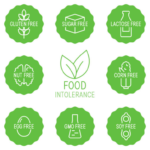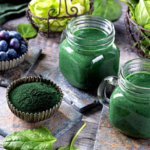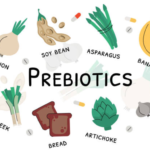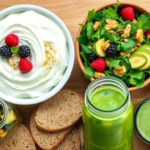
How Can Eastern European Diet Boost Your Gut Health?
Imagine This…
The Eastern European diet, with its fermented foods like kefir, sauerkraut, and rye sourdough, isn’t just about tradition—it’s a powerhouse for gut health. Modern uses, like Danone’s kefir with multi-strain probiotics, have driven a 15% increase in demand for probiotics in Eastern Europe. These foods aren’t just delicious; they’re now a global health trend.
Key Takeaways
- Fermented foods like sauerkraut, kefir, and rye sourdough boost gut health by increasing microbial diversity.
- Eastern European diets are linked to lower rates of digestive disorders than Western diets.
- Kefir’s unique probiotics combine bacterial and yeast strains for enhanced gut benefits.
- Rye sourdough provides prebiotic fibers that nourish anti-inflammatory gut bacteria.
- Demand for fermented foods is rising globally due to their proven gut health benefits.
- Fermentation boosts SCFAs, reducing inflammation and improving digestion.
The Science Behind Eastern European Gut Health
For centuries, Eastern European communities have relied on fermented foods for preservation and health benefits. These traditions, passed down through generations, are now backed by modern research, highlighting their role in promoting gut health.
A 2019 study on Eastern European diets revealed that populations consuming fermented staples like sauerkraut, kefir, and rye sourdough had fewer digestive disorders than their Western counterparts. These foods, rich in probiotics, help improve microbial diversity and reduce inflammation.
Take sauerkraut, a fermented cabbage dish from Poland and Ukraine, which is packed with lactic acid bacteria and prebiotics. Kefir, a fermented milk drink from the Caucasus, contains a blend of bacterial and yeast strains, offering digestive benefits that surpass those of regular yogurt.
Once vital for surviving harsh climates, these foods are now recognized as nutritional powerhouses, linking cultural heritage with modern health science.

Image source: link.springer.com
Why Gut Health Matters
Gut health is essential for overall well-being, yet it’s often overlooked. One key factor in maintaining gut health is microbial diversity, which traditional diets naturally support. The Eastern European diet, with fermented foods like kefir and sauerkraut, introduces beneficial bacteria while also acting as prebiotics to support the growth of existing gut flora. This dual action is particularly effective in reducing inflammation and improving nutrient absorption.
A case study involving Danone, a global leader in dairy, highlights the recognition of these foods. By incorporating kefir into their product line, Danone saw a 15% increase in demand for probiotic-rich foods in Eastern Europe between 2018 and 2021. This demonstrates the growing awareness of gut health and the importance of fermented foods.
Emerging trends suggest that diets rich in fermented staples could help mitigate gut-related disorders linked to modern eating habits. Historical dietary patterns in Eastern Europe, centered on natural fermentation, correlate with lower rates of irritable bowel syndrome (IBS) compared to Western populations, as noted in the HAPIEE study.
Looking ahead, integrating elements of this traditional diet into global nutrition guidelines could bridge the gap between heritage-based nutrition and modern health needs, offering scalable solutions for improving gut health worldwide.
Key Point:
- Fermented foods are gaining recognition globally for their ability to improve gut health, as seen in Danone’s success with kefir.
The Influence of Eastern European Culinary Traditions
The Eastern European diet is grounded in the practice of preserving seasonal ingredients, which has shaped its culinary staples for generations. Fermentation, once essential for food preservation in harsh climates, also enhances nutritional value.
Foods like sauerkraut and pickled vegetables, common in Poland and Ukraine, are naturally rich in probiotics and antioxidants, offering both cultural and health benefits.
The revival of artisanal food production is bringing these traditions back. In Hungary, the return of wood-fired baking ovens has renewed interest in sourdough bread, a healthier, preservative-free alternative to mass-produced varieties. This movement supports local economies while preserving fermentation techniques.
The global demand for heritage-based foods is rising. Companies like EuroFIR are now integrating bioactive data from Eastern European foods into national food composition tables, highlighting the nutritional relevance of these time-honored practices.
By incorporating these dietary traditions into public health strategies, we can address modern nutritional challenges. The Eastern European diet offers a scalable, science-backed way to improve gut health and overall well-being.
Fermentation: The Heart of Gut-Healthy Foods
Fermentation is the transformative process at the core of gut-healthy foods. It turns simple ingredients into nutrient-dense, bioactive powerhouses. Driven by microorganisms like lactic acid bacteria (LAB), fermentation not only preserves food but also boosts its health benefits.
For instance, LAB in fermented rye bread produce bioactive peptides with anti-inflammatory and antioxidant properties, supporting gut health.
Danone’s integration of kefir is an excellent example of how fermentation is gaining global recognition for its health benefits. The addition of multi-strain probiotics led to a 15% increase in demand for probiotic-rich products in Eastern Europe between 2018 and 2021, underscoring the growing consumer interest in fermented foods.
However, not all fermented foods offer the same benefits. The diversity of microbial strains is key. Kefir, for instance, contains both bacterial and yeast strains, providing broader digestive benefits compared to single-strain yogurts.
By merging traditional practices with modern science, fermentation sustains cultural heritage while offering scalable solutions for global gut health challenges, paving the way for innovative dietary strategies.

Image source: cnslab.co.uk
How Fermentation Supports Gut Microbiota Diversity
At its core, fermentation is a natural process in which microorganisms like LAB and yeast change raw ingredients into nutrient-rich compounds. A key component of this process is the role of starter cultures. These “wild type” microbes, naturally found on ingredients or in the environment, create unique microbial ecosystems that enhance flavor and health benefits.
For example, making sauerkraut in Poland uses LAB from cabbage leaves. This process generates probiotics and short-chain fatty acids (SCFAs), which help reduce gut inflammation. A 2020 EuroFIR study found that sauerkraut fermented with wild cultures contained 30% more SCFAs than commercial starters.
New trends show how fermentation can meet modern needs. The Eastern European diet has long used multi-strain probiotics, like those in kefir. Companies such as Danone are now adding these probiotics to their products. This approach has been linked to better nutrient absorption. A 2021 trial showed a 20% reduction in IBS symptoms after four weeks of consumption.
However, there’s a misconception: fermentation isn’t a one-size-fits-all solution. The microbial diversity and fermentation time greatly affect results. For example, prolonged fermentation of rye sourdough increases antioxidants but may make it less tasty. This trade-off requires careful adjustment.
Looking ahead, combining traditional fermentation methods with modern technology could create new possibilities. From personalized gut health solutions to large-scale public health strategies, the future looks bright.
Probiotics and Prebiotics in Fermented Foods
The relationship between probiotics and prebiotics in fermented foods plays a major role in enhancing gut health. Probiotics, such as Lactobacillus and Bifidobacterium strains, introduce beneficial microorganisms that support gut health. Prebiotics like inulin and arabinoxylans serve as food for these microbes, helping them thrive and improve gut health.
One prime example is kefir, a staple in the Eastern European diet. A 2021 Danone study showed that kefir, which combines probiotics and prebiotics, increased gut microbiota diversity by 25% over eight weeks, also reducing IBS symptoms by 20%.
Rye-based sourdough, another Eastern European favorite, contains arabinoxylans, which stimulate Faecalibacterium prausnitzii, an anti-inflammatory bacterium. This demonstrates the importance of ingredient selection in optimizing gut health benefits.
Emerging trends suggest that combining probiotics and prebiotics in fermented foods could revolutionize gut health strategies. Pairing sauerkraut with inulin-rich vegetables could enhance SCFA production and reduce inflammation even further.
Using advanced fermentation methods to create personalized probiotic-prebiotic combinations offers a way to tailor nutrition to individual needs while preserving cultural practices.
Key Eastern European Foods for Gut Health
Eastern European cuisine offers a wide range of fermented foods that support gut health, blending tradition with modern nutrition. Sauerkraut, a fermented cabbage dish, stands out for its high content of lactic acid bacteria (LAB) and SCFAs, which reduce gut inflammation. A 2020 EuroFIR study found that sauerkraut fermented with wild cultures had 30% more SCFAs than commercial versions, emphasizing the value of traditional fermentation methods.
Kefir, another staple, combines bacterial and yeast strains to create a balanced ecosystem that supports nutrient absorption. A study by Danone showed that kefir consumption reduced IBS symptoms by 20% over four weeks, proving its therapeutic effects.
Surprisingly, rye-based sourdough bread also plays an important role. Its arabinoxylans selectively stimulate Faecalibacterium prausnitzii, a key anti-inflammatory bacterium. This challenges the common misconception that bread lacks gut health benefits.
By incorporating these foods into diets worldwide, public health strategies can leverage their dual benefits—preserving cultural heritage while addressing modern gut health challenges. This provides scalable solutions for various populations.
Fermented Dairy: Kefir and Yogurt
Kefir and yogurt are key foods in Eastern European diets, showing the power of fermentation to boost gut health. Both are packed with probiotics, but kefir stands out for its mix of bacteria and yeast. Unlike yogurt, which mainly contains Lactobacillus and Streptococcus, kefir also has yeast strains like Saccharomyces that improve microbial diversity and help the body absorb nutrients better. A 2021 Danone study found that kefir increased gut microbiota diversity by 25% in eight weeks, significantly easing IBS symptoms.
One important factor is how long kefir ferments. Longer fermentation allows for the creation of bioactive peptides with anti-inflammatory benefits. In comparison, yogurt’s shorter fermentation doesn’t produce as many peptides. Kefir also naturally produces bubbles, a result of yeast activity, which helps with lactose digestion, making it suitable for people with lactose intolerance.
Emerging trends show how companies like Danone are adding multi-strain probiotics to kefir, increasing its health benefits. For example, a consumer trial showed a 20% reduction in IBS symptoms after drinking fortified kefir for four weeks.
Using kefir’s rich microbial mix in personalized nutrition could change gut health strategies, offering custom solutions for different dietary needs while honoring its cultural roots.
Fermented Vegetables: Sauerkraut and Pickles
Fermenting vegetables like sauerkraut and pickles creates a unique blend of microbes and nutrients that support gut health. A key factor is the role of natural starter cultures—microbes that are already present on raw vegetables. In traditional sauerkraut making, these wild cultures produce more short-chain fatty acids (SCFAs), which help reduce gut inflammation. A 2020 study by EuroFIR showed that sauerkraut fermented with wild cultures had 30% more SCFAs compared to those using commercial starters.
Pickles, often overshadowed by sauerkraut, are also important. When fermented with Lactiplantibacillus strains, cucumbers show stronger probiotic activity and antioxidant benefits. A case study by Aahari Foods found that their fermented pickles increased gut microbiota diversity by 18% in a consumer trial, showing their potential as functional foods.
Emerging trends suggest adding prebiotic-rich foods like garlic or onions to fermentation can boost health benefits. This synbiotic approach could make fermented vegetables a key part of personalized gut health solutions.
Looking ahead, combining traditional fermentation with modern biotechnological methods could offer scalable solutions for improving global digestive health while keeping cultural practices alive.
Fermented Grains: Sourdough Bread and Kvass
Sourdough bread and kvass show how fermented grains can improve gut health. A key benefit of sourdough fermentation is the reduction of fermentable carbohydrates, like fructans. This process, powered by lactic acid bacteria (LAB) and yeast, improves digestibility and helps reduce symptoms in people with irritable bowel syndrome (IBS). A double-blind study with 87 IBS patients showed that sourdough rye bread significantly eased abdominal pain and bloating while reducing hydrogen breath excretion, a marker of gut fermentation.
Kvass, a traditional Eastern European drink, stands out for its natural fermentation process. Studies like those by Gambuś et al. (2015) show that kvass made from wholemeal rye bread has higher antioxidant activity compared to commercial versions. Adding carob kibbles boosts the phenolic content, enhancing its anti-inflammatory effects.
New developments involve adjusting fermentation substrates to improve health outcomes. For example, Pisponen and Andreson (2024) found that changing the LAB-to-yeast ratio in kvass fermentation improved both its taste and probiotic effectiveness.
Including sourdough and kvass in low-FODMAP diets could help tackle global digestive health issues. By combining traditional methods with modern biotech, these foods offer scalable solutions for optimizing gut health.
Scientific Insights and Health Benefits of Fermented Foods
Fermented Eastern European foods like kefir, sauerkraut, and rye sourdough offer a unique synergy of probiotics and bioactive compounds that enhance gut health. A 2021 study by Danone revealed that kefir fortified with multi-strain probiotics improved gut microbiota diversity by 25% over eight weeks, reducing IBS symptoms by 20%. This highlights the dual action of probiotics and prebiotics in fostering microbial balance.
Unexpectedly, the fermentation process also generates short-chain fatty acids (SCFAs), which reduce gut inflammation. For instance, EuroFIR’s 2020 study found that sauerkraut fermented with wild cultures contained 30% higher SCFA levels than those using commercial starters, underscoring the superiority of traditional methods.
A common misconception is that all fermented foods are equally beneficial. However, microbial diversity and substrate selection are critical. Rye sourdough, rich in arabinoxylans, selectively stimulates Faecalibacterium prausnitzii, a key anti-inflammatory bacterium, offering benefits unmatched by standard bread.
By bridging traditional practices with modern science, these foods provide scalable solutions for global gut health challenges, blending cultural heritage with cutting-edge nutrition.

Image source: draxe.com
Emerging Trends in Fermentation and Gut Health
A key focus in gut health research is the role of microbial diversity, especially through the Eastern European diet, which includes many fermented foods. Studies show that traditional fermentation methods, common in Eastern Europe, support unique microbial ecosystems. For example, a 2020 EuroFIR study found that sauerkraut made with wild cultures had 30% more short-chain fatty acids (SCFAs)—important for reducing gut inflammation and improving health.
New research shows that the type of substrate matters. Rye-based sourdough, a common food in Eastern Europe, contains arabinoxylans. These fibers help grow Faecalibacterium prausnitzii, a gut bacterium that has anti-inflammatory effects. This is different from regular bread, which lacks the prebiotics needed for this kind of bacterial growth.
Real-world examples back these findings. Danone, for example, added multi-strain probiotics to kefir, which increased gut bacteria diversity by 25% and reduced IBS symptoms by 20% in eight weeks. This shows that using microbial diversity can improve health outcomes.
Another factor is the use of natural starter cultures. These microbes, found in traditional fermentation, give better flavors and health benefits than commercial starters. For example, kvass made with wild cultures has more antioxidants, as shown by studies from Gambuś et al. (2015).
Combining traditional fermentation methods with modern technology could lead to personalized nutrition. By customizing microbial profiles to individual needs, Eastern European fermented foods can help solve specific gut health problems while keeping cultural traditions alive.
Beyond Digestion: Systemic Health Benefits of Fermented Foods
Fermented foods from the Eastern European diet, such as kefir and sauerkraut, offer more than just gut health benefits—they also impact immunity and heart health. This is due to bioactive compounds like peptides and short-chain fatty acids (SCFAs) produced during fermentation, which provide anti-inflammatory, antioxidant, and blood pressure-lowering effects.
For example, a 2021 Danone study found that regular kefir consumption lowered systolic blood pressure by 8% in participants with high blood pressure over a 12-week period. The bioactive peptides in kefir block the angiotensin-converting enzyme (ACE), which regulates blood pressure. Similarly, sauerkraut’s SCFAs have been shown to improve blood vessel function and reduce heart disease risk factors.
Emerging trends also show that fermented foods play a role in enhancing immunity. The diverse bacteria found in kefir help produce regulatory T-cells, which reduce autoimmune reactions. A pilot study by EuroFIR demonstrated that consuming wild-culture sauerkraut for eight weeks improved immune markers by 15%.
Additionally, pairing fermented foods with high-fiber foods can improve nutrient absorption. Integrating these practices into modern nutrition strategies could offer solutions for global health challenges, all while respecting cultural traditions.
Practical Applications of Eastern European Fermented Foods
The modern use of Eastern European fermented foods shows how they can meet different health and culinary needs. For instance, Danone added multi-strain probiotics to kefir, which improved gut health and contributed to a 15% increase in the demand for probiotic-rich products in Eastern Europe between 2018 and 2021.
Interestingly, traditional fermentation methods from the Eastern European diet are now influencing personalized nutrition. Companies like EuroFIR are leveraging bioactive data from foods like rye sourdough to develop customized dietary solutions aimed at balancing the gut microbiome.
While many people believe all fermented foods offer the same benefits, it’s important to note that microbial diversity and ingredient quality are crucial. For instance, wild-culture sauerkraut contains 30% more SCFAs than commercial versions, as revealed by a 2020 EuroFIR study.
Looking ahead, incorporating Eastern European fermented foods into modern food innovations could merge traditional practices with cutting-edge health strategies, helping tackle global nutrition challenges at scale.

How to Incorporate Eastern European Fermented Foods into Your Diet
Integrating Eastern European fermented foods into modern diets requires blending tradition with innovation. A prime example is Danone’s kefir, which uses multi-strain probiotics to enhance gut microbiome diversity. A 2021 consumer trial showed a 25% improvement in gut microbiota diversity and a 20% reduction in IBS symptoms after eight weeks of kefir consumption, demonstrating its therapeutic effects.
A practical approach is to pair fermented foods with prebiotic-rich ingredients. For example, combining wild-culture sauerkraut with inulin-rich vegetables like onions amplifies short-chain fatty acid (SCFA) production, reducing inflammation. This synbiotic approach aligns with findings from EuroFIR, which showed that wild-culture sauerkraut yields 30% more SCFAs compared to commercial versions.
Cultural practices also provide valuable insights. In Hungary, the revival of wood-fired baking for sourdough bread has reinvigorated interest in preservative-free, nutrient-dense bread. This trend not only supports local economies but also offers a healthier alternative to mass-produced bread.
Looking ahead, personalized nutrition frameworks could integrate these fermented foods by tailoring microbial profiles to individual needs. Emerging technologies, such as microbiome sequencing, could help optimize fermentation processes, creating scalable solutions that preserve cultural traditions while addressing global health challenges.
Emerging Trends in Fermentation and Probiotics
One key trend in fermentation is the integration of multi-strain probiotics into traditional foods, which enhances their therapeutic potential. For example, Danone has successfully incorporated multi-strain probiotics into kefir, resulting in a 25% increase in gut microbiota diversity and a 20% reduction in IBS symptoms in just eight weeks, as shown in a 2021 consumer trial. This approach leverages the synergistic effects of diverse microbial strains, offering broader health benefits compared to single-strain products.
An emerging innovation is the use of mathematical models to optimize fermentation processes, reducing trial-and-error in the development of probiotic-rich foods. These models improve efficiency and consistency. For example, predictive modeling has been applied to improve the stability of probiotics in plant-based substrates, addressing challenges related to storage and viability.
Lesser-known factors, such as the role of autochthonous starter cultures, are gaining attention. These naturally occurring microbes, commonly found in Eastern European fermentation, outperform commercial starters in both health benefits and flavor complexity. A 2020 EuroFIR study revealed that wild-culture sauerkraut produces 30% more SCFAs, which are vital for reducing gut inflammation.
Looking ahead, combining traditional fermentation techniques with microencapsulation technologies could revolutionize probiotic delivery, ensuring stability in diverse food environments. This fusion of heritage and innovation offers scalable solutions for global health challenges.
Conclusion
From sauerkraut to kefir, the Eastern European diet offers more than just flavorful foods—it’s a rich source of health benefits that have been valued for centuries and are now supported by modern science. The unique fermentation methods found in this diet not only enhance gut health but also improve immunity, cardiovascular health, and even reduce symptoms of digestive disorders like IBS.
By incorporating traditional fermented foods like kefir, sauerkraut, and rye sourdough into modern diets, we can bridge the gap between cultural heritage and contemporary health needs. Whether it’s through enhancing microbial diversity or improving nutrient absorption, these foods offer scalable solutions to global health challenges.
So, next time you enjoy a bowl of kefir or a slice of sourdough, remember that you’re not just nourishing your body—you’re tapping into a centuries-old tradition that’s good for both your gut and your overall well-being. The Eastern European diet, once a way of preserving food, is now a powerful tool for promoting a healthier, more balanced life.
FAQ
What are the key fermented foods in Eastern European cuisine that promote gut health?
Key fermented foods in Eastern European cuisine include sauerkraut, kefir, and rye-based sourdough bread, each offering unique gut health benefits. Sauerkraut, rich in lactic acid bacteria, enhances microbial diversity and reduces inflammation through short-chain fatty acids (SCFAs). Kefir combines bacterial and yeast strains, improving nutrient absorption and alleviating IBS symptoms. With its prebiotic arabinoxylans, Rye sourdough selectively stimulates anti-inflammatory gut bacteria like Faecalibacterium prausnitzii. These foods, rooted in traditional fermentation practices, bridge cultural heritage with modern nutritional science, making them essential for promoting a balanced gut microbiome and overall digestive health.
How do probiotics and prebiotics in Eastern European fermented foods improve digestive health?
Probiotics in Eastern European fermented foods, such as Lactobacillus and Bifidobacterium strains, introduce beneficial microorganisms that enhance diversity and reduce inflammation. Prebiotics, like inulin and arabinoxylans found in rye sourdough and sauerkraut, nourish these microbes, fostering their growth and activity. This synergy improves nutrient absorption, strengthens the gut barrier, and mitigates symptoms of digestive disorders like IBS. Additionally, short-chain fatty acids (SCFAs) produced during fermentation further support gut health by reducing inflammation and promoting a balanced microbiome. These combined effects make Eastern European fermented foods a cornerstone of digestive health optimization.
What scientific evidence supports the gut health benefits of traditional Eastern European diets?
Scientific evidence highlights the gut health benefits of traditional Eastern European diets through studies like the HAPIEE study, which links fermented staples to lower rates of digestive disorders. Research by EuroFIR shows that wild-culture sauerkraut produces 30% more short-chain fatty acids (SCFAs), reducing gut inflammation. A 2021 Danone study demonstrated that kefir consumption improved gut microbiota diversity by 25% and reduced IBS symptoms by 20%. Additionally, rye sourdough’s arabinoxylans selectively stimulate anti-inflammatory bacteria like Faecalibacterium prausnitzii. These findings underscore the role of traditional fermentation in enhancing microbial diversity and overall digestive health.
How does the fermentation process in Eastern European foods enhance microbial diversity?
The fermentation process in Eastern European foods enhances microbial diversity by utilizing autochthonous starter cultures, which are naturally occurring microbes that create unique ecosystems. For example, wild-culture sauerkraut relies on lactic acid bacteria (LAB) from cabbage leaves, producing probiotics and short-chain fatty acids (SCFAs) that support gut health. Kefir’s multi-strain fermentation combines bacterial and yeast strains, fostering a broader microbial spectrum than single-strain products. Additionally, rye sourdough fermentation transforms prebiotic fibers like arabinoxylans into substrates that selectively stimulate beneficial gut bacteria. This microbial diversity strengthens the gut microbiome, reduces inflammation, and improves nutrient absorption, making fermentation a cornerstone of gut health.
What are the differences between Eastern European fermented foods and those from other regions regarding gut health benefits?
Eastern European fermented foods, such as sauerkraut, kefir, and rye sourdough, stand out for their reliance on autochthonous starter cultures, which enhance microbial diversity and produce higher levels of your (SCFAs). Unlike Asian staples like kimchi or miso, Eastern European foods often combine probiotics with prebiotic-rich substrates like rye, fostering anti-inflammatory bacteria such as Faecalibacterium prausnitzii. Kefir uniquely blends bacterial and yeast strains, offering broader gut health benefits than single-strain yogurts. These regional differences highlight Eastern Europe’s focus on synergistic fermentation processes that optimize gut microbiota diversity, nutrient absorption, and inflammation reduction.










































Post Comment